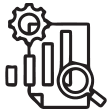Revenue Growth Management: Leveraging it Right to Manage Inflationary, Pandemic Environments
The COVID pandemic along with the subsequent international lockdown was a major disruption for global trade, and most industries devolved into a state of crisis. But the CPG industry witnessed a very different response to these external factors.
Traditional strategies for revenue management in CPG were using Pricing Optimization and Promotion Management, but these methods were reactive and not well suited for today’s evolving e-commerce environment. The analytics was handled manually, the insights were available only after a campaign had already been launched, and there was no room for scaling the activity.
Today, omnichannel business success demands a certain scalability and flexibility when it comes to analytics and the availability of real-time insights that can drive effective pricing and promotion strategies for both short and long-term success.
The Need for Advanced Analytics in RGM Initiatives
Here’s a quick look at some of the drawbacks of traditional RGM, and why it’s being phased out.
- Being dependent on historical data, traditional Revenue Growth Management (RGM) doesn’t offer a 360o view of data, that can account for the shift in consumer behavior and purchase patterns being witnessed by the CPG industry.
- Added to this, is the fact that there is low cash flow because of a selective focus on high-growth products.
- Then there is a disconnect between field staff and the back office where consumer planning is still siloed and based on limited business intelligence.
- As a result, long-term goals are ignored for quick wins, and unsustainable business plans don’t contribute to revenue growth.
For CPG companies to grow their business, they needed to embrace a data-based business model. Where their analytics-based RGM strategies offer prescriptive insights to combat disruptions in the supply chain, the growing popularity of direct-to-customer (D2C) e-commerce, and account for new consumers and competition.
The Boston Consulting Group concluded after a survey, that 95% of companies that had undergone a digital transformation before the pandemic, were leveraging at least one solution for their revenue growth initiatives. They also reported that 77% of these companies attributed about 50% of their revenue generated to AI-led RGM solutions. This reinforces the need for RGM strategies to be central to every CPG company’s business strategies, irrespective of business function.
AI-Based RGM – The Way Forward
Digital transformation has empowered organizations with cutting-edge AI and analytics capabilities, coupled with advanced computing power, to leverage the massive data sets which are at the disposal of key decision-makers. These advances make it possible to automate analytics for RGM initiatives that offer actionable insights, pin-points problems, identify opportunities, and serve prescriptive recommendations for business optimization and revenue growth.
An AI-based RGM solution can help a CPG company to identify opportunities to optimize trade, pack pricing, SKU mix, channel mix, and the profit pool; without human intervention. The company steps in to align its different business functions with the opportunities that are presented so that they can be implemented at the consumer level.
The automated analytics solution continues to track the impact of the decisions taken and the actions implemented, offering real-time feedback and estimating ROI. The feedback loop coupled with the AI’s machine learning capabilities helps to refine business decisions and optimize business growth.
The RGM solution further helps CPG companies to – improve data governance, discover hidden value, optimize metrics at a base level, eliminate excess marketing spend, enhance enterprise reporting, and create long-term value by re-designing business processes.
This integrated approach to RGM covers all the bases for a CPG company engaged in an omnichannel business model.
The RGM initiatives help to optimize pricing, marketing activities, distribution strategies, and product assortment at both the enterprise and the consumer front, across all channels. This in turn drives a profitable top line and helps grow revenue.
Strategic Revenue Management with Course5
Course5 has been an analytics partner for multiple Fortune 100 companies from the CPG industry and has been helping to develop effective revenue growth strategies. We understand your business problems and align our analytics solutions with your objectives for revenue growth.
Pricing Analysis and Promotion Optimization are two key elements of RGM, and Course5 delivers on client requirements with our holistic solution based on Advanced Analytics. The four pillars of our analytics solution include Order Value Pricing, Competitor Intelligence, Price Elasticity, and Consumer Promotions.

Quantity-based Price Optimization Models
Price Optimization models are based on the variety of parameters considered, such as client tiers, periodic purchases, and business trends. We analyze market conditions, trends, profit goals, etc. to conduct intelligent tier selection and maximize revenue.

Price Position vs. Competitors
Leverage competitors’ pricing and understand price position with competitors’ pricing to understand competitive effects.

Promotions Impact Analysis
It considers holidays, promotions, seasonality, media, and coupons in analyzing the impact on volumes, and uplift due to promotions.

We compute this metric for each product line, season, and key customer segment, if possible. This helps to understand the effects of price change and Price Band forecasting.
The RGM solution from Course5 follows an incremental process for execution and insight generation. The process is as follows –
- Business Understanding and Situation Analysis – Understand historical trends for the brand and category. Understand the business problems and objectives from the current pricing exercise.
- Data Collection and Structuring – Support data collection from the client’s site and convert the data to a format compatible with modeling.
- Exploratory Analysis – Discuss with the business teams exploratory analysis, trends, and initial hypotheses.
- Modeling – Model discussions and reviews with the business teams to further crystallize the hypothesis and related findings.
- Analysis, Simulation, and Reporting – Workshop to run various scenarios using our proprietary Price Promotion Simulator. Deliver PowerPoint report on Recommendations and actions for price mix changes, estimated impact on the net revenue and volume, opportunities, and risks associated with each scenario.
Last but not the least, having done the above, the important aspect is to drive the solution at scale. It should empower decision-makers to be able to access the insights in an easy-to-consume recommendation manner. 75% of the organizations that are able to develop sophisticated RGM models are restricted in their decision-making due to the lack of adoption of applied AI.
At Course5, we do the heavy lifting while you get to access actionable insights and prescriptive recommendations to monitor, access, and control investment levels across promotion types and product categories. Let AI power your analytics and analytics drive your RGM initiatives. Let data drive decisions, and watch your business thrive.

Imran Saeed
Imran leads Course5’s Global CPG Practice, developing new AI + tech-enabled solutions for Fortune 500 clients, maximizing impact at scale with emphasis on empowering decision...Read More

Don’t miss our next article!
Sign up to get the latest perspectives on analytics, insights, and AI.






